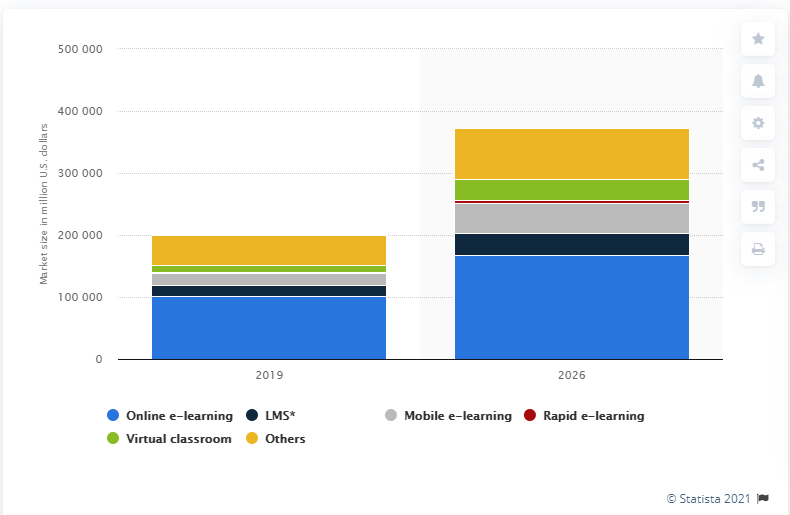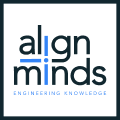MODIFIED ON: November 28, 2022 / ALIGNMINDS TECHNOLOGIES / 0 COMMENTS

Place and time. These are the two main barriers men have always despised. Ever since the adoption of technology, we as humans have been somewhat successful in breaking these barriers.
In recent times, one of the industries that are seeing the fastest growth due to the elimination of these barriers with the help of technology in the education industry. Learningnews reports that the e-learning market will exceed USD 375 billion in 5 years. According to Global Market Insights, the e-Learning Market size is set to exceed USD 1 trillion by 2027.
The below graph shows the size of the global e-learning market in 2019 and 2026, by segment in million U.S. dollars

(Source: Statista)
According to the research,
“In 2019, the global online e-learning market was sized at approximately 101 billion U.S. dollars. During that same period, learning management system market generated roughly 18 billion U.S. dollars. By 2026, the total market for e-learning worldwide is forecasted to grow exponentially, reaching over 370 billion U.S. dollars”.
The reason for this exceptional growth is now people are looking to learn from the comfort of their home or they have very limited time that they can invest in learning and looking for something flexible so that they can learn whenever they have free time. Also, the pandemic has boosted the growth of the e-learning industry since people have no option to go out and there are restrictions put down by the government in so many countries. So many EdTech companies tapped into this opportunity and invested heavily in e-learning solutions to meet the demand.
What is e-learning?
Economic times defines e-learning as
A learning system based on formalised teaching but with the help of electronic resources is known as E-learning. While teaching can be based in or out of the classrooms, the use of computers and the Internet forms the major component of E-learning.
However, not just computers, students and teachers are using other devices like smartphones and tablets that support connectivity to participate in an e-learning system. In fact, smartphones have become one of the strong pillars of e-learning systems due to them being more affordable and mobile. Almost all e-learning systems have a native version for at least the major mobile platforms, Android and iOS.
What is an e-learning app?
An e-learning app is an application that is built specifically to impart knowledge, encourage creativity, and most importantly encourage healthy dialogues between teachers and students to simplify the process of learning.
As mentioned earlier the process of E-learning is performed through an application like a mobile app which can be easily downloaded through your Android and or iOS devices. It is a closed-end system ensuring effective privacy and security to both teachers and students ensuring a safe environment for all the participants. The interface used in the app is simple and easy to use making it a comfortable place for students to learn each topic.

How to create an e-learning app?
There is no doubt in anybody’s mind that the e-learning app is the future of learning, the pandemic has further solidified this observation. e-learning apps are a global phenomenon, and it is the right time to capitalize on the same. As per Reuters, the e-learning App industry is expected to touch $275 billion globally.
Now, the billion-dollar question of 2021 is how to develop an e-learning app, e-learning app development consist of five steps they are as follows:
1. Identify and develop the concept
The next step in how to create an e-learning app process is to further develop your concept. This stage can be defined with the help of six key product dimensions they are as follows:
Target audience
The first step in the process of developing an e-learning app is identifying the target market. The biggest question to be answered in this stage is who is your app catering to? For example, is it for elementary school students or for bachelors’ students, masters, STEM field, architect, or just a general portal that provides diverse educational material?
The right target group must be identified as it influences the e-learning app development process. If the target audience is elementary kids, then the fonts used in the app will have bright attractive colours and a lot of animation to capture the attention of the children.
Public vs Private
The next important factor to consider is will the app be available to the public or will the information be accessed only to a close group. For example, if your e-learning mobile app development is for an educational institution like school or college then it is important to make the app private.
Geographical scope
Is the app directed for specific geography like India or is it for a specific economic area like the EEA? such decisions will play a vital role while developing the app. Each country has its unique grading systems, class structures, and so on, which are very important considerations while developing an e-learning app.
Customizability
Is your product flexible enough to be customized as per the requirement of each organization?. Is it possible to add or delete certain functions in your app to suit the requirements of each customer or is it a non-flexible product targeted at a specific crowd? Clearly, an important topic to consider.
One way vs two-way communication
Does the e-learning app have two-way communication enablers like video telephony, videoconferencing, voice call, and so on? Two-way communication is especially useful for universities and schools that might require frequent student-teacher interactions. Does the market require one-way communications like lectures, pre-set audio files, slides, and so on? It is important to keep this aspect in mind while developing the e-learning platform.

Price
Price is arguably one of the most important dimensions while identifying the scope of the app. Will the app be paid or unpaid? and if it is paid how do you expect to get paid, is it a monthly subscription, or it is based on the modules, contents consumed, and so on. A perfect price strategy can determine the success of the product.
2. Competitor analysis/Feasibility study
The research phase is an important phase in the e-learning mobile app development process. In this phase, the individual concerned will have to do extensive research on the competitors. It is very important to be aware of the latest developments in the industry and to be updated about the same. Once thorough research is performed it is safe to move to the next stage, selecting a development partner.
3. Selecting a development partner: e-learning app development company
Selecting a development partner for developing your e-learning project is very essential to ensure timely delivery of the product. While selecting the e-learning app development company it is important to look at their past projects and judge based on their success. You could also contact their previous clients to know more about the quality and performance of the e-learning app development company. Associate with a company only after you are 100% satisfied with identifying who they are and what their capabilities are.
4. Promotion and advertisements
Even though this step cannot be counted as a core aspect of how to create an e-learning app, nevertheless it is a very important step. No product however good it may be will not survive without proper promotions and advertisements. It is important to engage with potential businesses across the spectrum through both conventional as well as new-gen advertisement platforms. Promotion and advertisements are a must-do in today’s dynamic environment to get the best ROI for your buck.
The essential character of e-learning app
e-Learning apps usually has a unique set of characters that makes the product flexible, dynamic, and user-friendly. Some of the most important characters of the e-learning app include the following:
1. User-friendly and intuitive interface
The e-learning website should be user-friendly, clear, and easy to operate. The functions in the dashboard should be marked clearly with clear fonts. There should be a logical flow of functions making the system predictable. All these factors enhance the functionality and the ease of operation of the product making it accessible to a wide array of audiences.

2. SCORM compliant
SCORM (Sharable Content Object Reference Model) compliance enables learning software, e-learning material to be compatible with SCORM compliant LMS. It is the industry technical standard that ensures efficiency and standardization within the overall ecosystem. Hence if you are looking to develop e-learning solutions it is important to comply with internationally accepted standards to ensure competitiveness and future proof.
3. Easy dissemination of Information
The platform should offer easy upload and dissemination of information for its users. The users should be able to upload different document formats like pdf, words, jpg, along with video and audio formats depending upon the requirements. Furthermore, this information should be easily available to the selected group. The platform should have the capability to offer selective viewership of the information along with selective editing capabilities and view-only modes to ensure a seamless experience.
4. Scalability
e-Learning platforms need to be scalable, depending on the user requirements. The app should have the necessary infrastructure to handle heavy traffic as and when required seamlessly. Scalability is not limited to the number of people it can cater to but also functionality, this makes the app future-proof. Scalability plays a vital role in making the product versatile, efficient, and relevant in today’s world.
5. Integrability, documentation, and reporting
In most probable cases e-learning platforms are not sold as a separate unit rather it is sold along with a fully integrated CRM system. This ensures data is transferred from one system to another with minimum effort. Documentation function helps e-learning platforms to document day-to-day functions, results, grades of students, subjects’ wise information, and so on to create functional information that can help identify the performance of an individual. This information can be reported to the appropriate authorities, parents at ease with a well-connected and integrated e-learning app.

6. Learning automation
e-Learning apps should have significant automation of rudimentary and repetitive tasks that otherwise consume a lot of time. The users should have the capacity to send reminders, information to any number of people with a push of a button. These functions help bring flexibility and efficiency to the learning process helping instructors to fully devote their time to the core aspect that is teaching.
How much does it cost to develop an e-learning app?
The cost of creating an e-learning app depends on the specification and functionality of the app. The specification and functionality of the app can be further divided into four major parts they are as follows:
1. General specification and functionality
General specifications and functionalities for an e-learning app usually include things like user-friendly interface, push notification facility, multiple device sync facilities (for example mobile, laptop, tablet, and so on), multimedia content support capability, graphical designs, and so on.
2. Students and parent specification and functionality
Let us look at student specifications and functionality in the first paragraph. Some of the key specifications and functionality required for students include registration for a course or a specific optional subject, course information, course structures, assessment upload portal, assessment marks and exam marks portal, payment portal receipt generation, and downloading facility to name a few.
In the case of a parent, they should have the ability to develop a profile for themselves so that they could monitor the progress of their children, pay fees, and so on.
3. Teacher’s specification and functionality
Teacher’s Specification and Functionality include the following: Editing course materials, submitting and sending new documents, sending and receiving information with the class (including all audio, video, document formats), being able to mark assignments, send push button notifications, and so on.
4. Admin specification and functionality
Admins are in a way the most powerful person who uses the app as he enjoys the maximum power of the lot. He shall have full access to the e-learning software. He shall have access to creating his personal profile, he shall have the ability to monitor, and manage the activities in the platform. He will have the required authority to troubleshoot problems and help carry out activities as requested by other stakeholders.

How do I market my e-learning app?
Marketing is an art that helps suppliers identify potential buyers and sell their products at the best price possible. It doesn’t matter how good the product is, only with appropriate marketing tools can it reach potential buyers which in turn converts to a sale. Some of the most widely used app marketing techniques include the following:
1. Identify and reach your target customer
The first step is to identify who your target customer is and then identify ways and means to reach them. The most popular means to reach your potential customers is through the use of social media platforms like Twitter, Facebook, Instagram, WhatsApp, YouTube, and so on. You could also take the help of Google ads, online forums, to further accelerate your outreach. Offline media include newspapers, magazines, scientific journals, and so on to reach your target audience.
2. Educate your potential customers on e-learning benefits
For this purpose, you could create small animation videos describing your app and how to use them. Finally ending the video with the benefits associated with the app. Visual messages have the capacity to captivate the audience hence they can offer a better customer acquisition rate when compared to other mediums.
3. Live demo
Let say you are targeting schools with your product, a live demo in front of school staff, teachers, and decision-making authorities could give you a better conversion possibility. Do not forget to allow your target audience to use your system and when they understand the simplicity of the system, they would certainly give it a thumbs up. You could even demonstrate the key strengths of the system and how it can simplify the work of the stakeholders using it.
4. Remind them about you through your online presence
Make sure you sign them up with your newsletter. Send them regularly about the new products developed by your, the new offers available, new functions available, and about popular events. You could even offer free passes to those events through your newsletter. Engage with them through multiple platforms like social media, ads, promotional emails, and so on. This will help you cement your brand name in their head.
These tips can surely help you grow your sales and eventually help you to expand your business beyond geographies and product verticals. Please note that understanding these tips does not automatically guarantee success but a careful and well-planned execution of the same will generate the right result.

Conclusion
e-Learning apps help to eliminate the distance between students and teachers. An e-learning app also makes education accessible to more people due to the flexibility it offers. However, to be fully effective and meet its purpose, an e-learning app should have a set of certain qualities that should be planned and implemented correctly. Such features are easy to be identified and implemented if you have the help of an experienced app developer. AlignMinds has more than 12 years of experience in developing trendsetting yet cost-effective digital solutions for multiple verticals. If you are looking for some ideas for your next project, contact us now!
Leave a reply
Your email address will not be published.
-
Recent Posts
- Unveiling the Future: The Role of AI in Spearheading Digital Transformation in 2024
- Chatbots vs. Conversational AI: Decoding the Mysteries Behind the Tech
- Leading the Pack: The Top Conversational AI Platforms Transforming Communication in 2024
- The Future of Work: Key Remote Staffing Trends Dominating 2024
- The Ultimate Guide to Choosing the Right Generative AI Company
-
Categories
- MVP Development (3)
- AlignMinds (55)
- Operating Systems (2)
- Android POS (3)
- Application Hosting (1)
- Artificial Intelligence (19)
- Big Data (2)
- Blockchain (1)
- Cloud Application Development (7)
- Software Development (30)
- Software Testing (9)
- Strategy & User Experience Design (4)
- Web Application Development (23)
- Cyber Security (6)
- Outsourcing (7)
- Programming Languages (3)
- DevOps (5)
- Software Designing (6)
- How to Code (4)
- Internet of Things (1)
- Machine Learning (2)
- Mobile App Marketing (4)
- Mobile Application Development (18)
- Mobile Applications (5)







